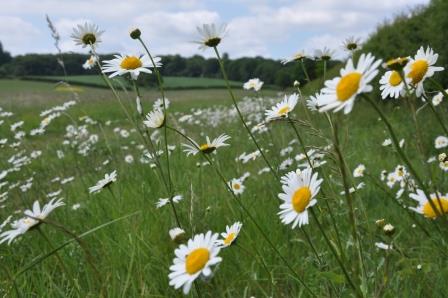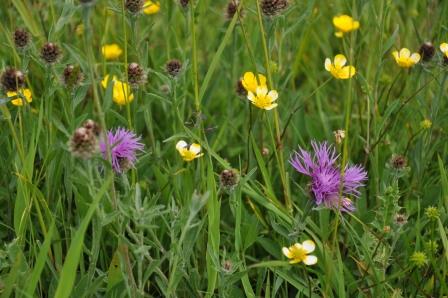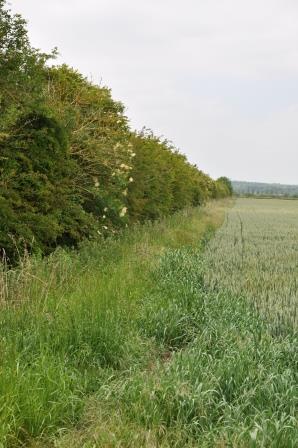Research
Plants on arable field margins
Arable field margins are key areas for biodiversity conservation in farmed landscapes. Their connectivity and varied habitats offer huge potential but their narrow, linear nature, and the common perception of them as weed reservoirs, present major challenges. These issues were addressed through two experiments designed to identify simple and inexpensive management regimes for enhancing biodiversity while controlling weeds. The first experiment used wide field margins with contrasting grass leys managed either as hay or silage. It showed that more species-rich leys have significant advantages for wildlife, amenity, and ease of management, while retaining forage potential and being more practicable than complex wildflower seed mixtures for large-scale use. Their cost effectiveness, however, depends on the management method and species chosen, a conclusion reinforced by the second experiment. This used swards established on narrower field margins by natural regeneration or by sowing a wildflower seed mixture. Treatments included manipulating the frequency and timing of mowing. Changes in plant species richness and sward composition over thirteen years showed that short-term studies are unlikely to be a good guide to the future. Species richness and sward composition changed substantially with time and were influenced by the local flora, sward establishment methods, and subsequent management regimes. The results provide specific and practical management prescriptions, and demonstrate that effective weed control can accompany biodiversity benefits. The experiments also help to provide the ecological tools needed to tailor field margin management to achieve a wide range of outcomes that might be desirable in different circumstances.
Helen Smith
Ruth E. Feber
David W. Macdonald
References
Smith, H., Feber, RE. & Macdonald, D.W. 2015. From weed reservoir to wildlife resource: redefining arable field margins. In: Wildlife Conservation on Farmland. Eds: D.W. Macdonald & R.E. Feber. Oxford University Press.
Smith, H., Feber, R.E., Morecroft, M.D., Taylor, M.E. and Macdonald, D.W. 2010. Short term successional change does not predict long term conservation value of managed arable field margins. Biological Conservation, 143, 813-822.
Vickery, J., Feber, R.E. & Fuller, R.J. 2009. Arable field margins managed for biodiversity conservation: a review of food resource provision for farmland birds. Agriculture, Ecosystems and Environment, 133, 1-13.
Macdonald, D.W., Feber, R.E., Johnson, P.J. and Tattersall, F. 2000. Ecological experiments in farmland conservation. In: The Ecological Consequences of Environmental Heterogeneity (Eds. M.J. Hutchings, E.A. John, A.J.A. Stewart). British Ecological Society Symposium. Blackwell Scientific Publications
Smith, H., Feber, R.E. and Macdonald, D.W. 1999. Sown field margins: why stop at grass? Aspects of Applied Biology, 54, 275-282.
Smith, H., Firbank, L.G. & Macdonald, D.W. 1999. Uncropped edges of arable fields managed for biodiversity do not increase weed occurrence in adjacent arable crops. Biological Conservation, 89: 107-111.
Smith, H., Mccallum, K. & Macdonald, D.W. 1997. Experimental comparison of the nature conservation value, productivity and ease of managment of a conventional and a more species-rich grass ley. Journal of Applied Ecology, 34: 53-64.
Smith, H., Feber, R.E. & Macdonald, D.W. 1994. The role of wildflower seed mixtures in field margin restoration. In: Field margins: integrating agriculture & conservation. BCPC Monograph, 58: 289-294. Ed. N.D. Boatman. British Crop Protection Council Publications, Farnham
Watt, T.A., Smith, H. & Macdonald, D.W. (1990). The control of annual grass weeds in fallowed field margins managed to encourage wildlife. In: Integrated weed management in cereals, pp. 187-196. Proceedings of the EWRS Symposium, Helsinki, 1990.
Smith, H. & Macdonald, D.W. 1989. Secondary succession on extended arable field margins: its manipulation for wildlife benefit and weed control. In: Brighton Crop Protection Conference: Weeds 1989, pp. 1063-1068. BCPC Publications, Farnham.
-
 © Ruth Feber
© Ruth Feber -
 © Ruth Feber
© Ruth Feber -
 © Ros Shaw
© Ros Shaw





